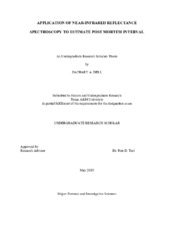| dc.description.abstract | Estimating the post mortem interval of human remains is extremely important in death scene investigations. Currently, the rate of decomposition is gaged by a number of techniques, such as insect development, a function in part of environmental and weather conclusions. However, there are limitations with the process that prevent more accurate assessments. Near-infrared reflectance spectroscopy may provide complimentary and supportive estimates of the post mortem interval. The goal of this research was to determine if near-infrared reflectance spectroscopy (NIRS) could detect changes in decomposing skin of feral swine as a model system. NIRS spectra were obtained from swine skin samples exposed to natural elements (daily temperature, precipitation, humidity and solar radiation) on the campus of Texas A&M University during warm (July) and cool (February) seasons. Linear regression analysis of spectral data by sample age and state of decomposition were found to be highly correlated (R2=0.8749) during the warm period exposure. The same regression analysis of spectral data taken during the cool exposure months produced an R2 of 0.812. | en |


